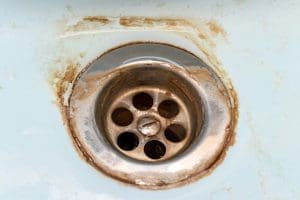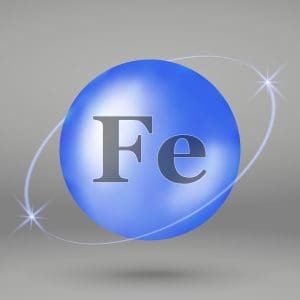 Southern Maryland’s iron levels frequently impact private wells and public water systems. You may be experiencing a metallic taste and/or reddish-brown stains on your sinks and laundry. Although not dangerous, the presence of iron can affect the overall quality of your water.
Southern Maryland’s iron levels frequently impact private wells and public water systems. You may be experiencing a metallic taste and/or reddish-brown stains on your sinks and laundry. Although not dangerous, the presence of iron can affect the overall quality of your water.
Geological conditions in Southern Maryland contribute to higher iron levels, so active water quality management is crucial for residents. Being aware of the signs of too much iron and how to remove it will help keep your water clear and taste fresh.
This article will discuss removing iron from your water, leaving you with beautiful, clean, great-tasting water at home. When you make informed decisions, high-quality water becomes part of your everyday experience.
Key Takeaways
- Properly monitoring iron levels in drinking water is critically important to the public health and safety of Southern Maryland. Too much iron can harm health and lead to aesthetic issues within residential plumbing.
- Maryland has set specific concentration limits for iron as water quality standards. The water remains within federal safety guidelines by continuing to observe these protocols. Regular testing is therefore advised to ensure safe levels are kept.
- This is because ferrous iron is often found in coastal groundwater sources. When oxidizing, it dissolves, leading to reddish-brown water discoloration and a metallic taste. These serious issues need to be addressed to ensure higher-quality drinking water.
- Ferric iron is standard in the bedrock regions of Southern Maryland and can lead to rusty-colored stains in household appliances and plumbing systems. Knowing the differences between ferric and ferrous iron is key to successful water treatment.
- Bacterial iron, related to iron bacteria, can cause slime accumulation and foul odors in water distribution systems. Potential health risks: In high concentrations, bacterial iron can become toxic.
- Testing and remediation are necessary steps to removing iron contamination. Select a skilled and dependable service provider to ensure optimal outcomes. Test routinely and plan a tailored remediating approach to deliver safe, clear water for day-to-day use.
Understanding Iron Levels in Maryland

What Are the State Guidelines?
Maryland’s water quality standards prescribe an upper threshold for iron concentration in drinking water. The state guidelines suggest that the iron level should be below 0.3 milligrams per liter. This measure aligns with federal water regulations, ensuring water safety and quality.
Given the widespread security vulnerabilities and health hazards associated with lead, strict compliance with these standards is imperative. To ensure that the levels of iron remain of no concern, ongoing testing of all water supplies would be prudent.
This forward-thinking approach does more than protect public health; it helps keep drinking water clean and tastes great.
 Note: Ferric iron refers to iron in its +3 oxidation state (Fe3+), while ferrous iron refers to iron in its +2 oxidation state (Fe2+) – essentially, ferric iron is a more oxidized form of iron compared to ferrous iron; in simpler terms, ferric iron has lost more electrons than ferrous iron. Generally, ferrous iron is more readily absorbed by the human body than ferric iron. Read More Here.
Note: Ferric iron refers to iron in its +3 oxidation state (Fe3+), while ferrous iron refers to iron in its +2 oxidation state (Fe2+) – essentially, ferric iron is a more oxidized form of iron compared to ferrous iron; in simpler terms, ferric iron has lost more electrons than ferrous iron. Generally, ferrous iron is more readily absorbed by the human body than ferric iron. Read More Here.
Ferrous Iron in Coastal Areas
Ferrous iron, predominantly found in groundwater sources in coastal plain geology, is a frequent issue in Southern Maryland. This iron is soluble in water, which means it can be transparent to the eye but still identifiable through water testing.
Ferrous iron can be a significant nuisance in household water systems. It can cause plumbing problems, stain laundry and fixtures, and even impart an unpleasant taste and odor to the water.
Understanding its solubility is important. It informs our treatment decisions, such as the need for aeration or oxidation to convert it into a more easily treatable form.
Ferric Iron in Bedrock Regions
Ferric iron is often more common in regions underlain by deep bedrock formations. Unlike ferrous iron, it is insoluble and typically visible, staining sinks and tubs with rust-colored stains.
This form of iron has distinct chemical characteristics from ferrous iron. It demands specific treatment techniques for removal.
All ferric iron is a clear sign of contamination. This highlights the need to make widespread, efficient filtration systems available to protect our water supply.
Types of Iron in Water
Ferrous Iron Characteristics
Ferrous iron, ordinary in many of Southern Maryland’s water supplies, looks clear when dissolved but turns reddish-brown when exposed to air and oxidizes. This soluble ferrous form does not have color immediately but oxidizes, leaving unpleasant red-brown stains on fixtures and laundry.
 Much like rusty nails, the metallic taste it gives water is a sure indicator of its presence. This has a significant impact on the water’s quality. It robs it of its aesthetic charm, making it both less pleasant to drink and more likely to stain things.
Much like rusty nails, the metallic taste it gives water is a sure indicator of its presence. This has a significant impact on the water’s quality. It robs it of its aesthetic charm, making it both less pleasant to drink and more likely to stain things.
Ferric Iron Sources
Ferric iron, the oxidized form, is easily seen because of its reddish-brown color. Sources come from natural soil composition and mineral deposits, and concentrations are increasing due to aging plumbing systems.
These aging systems contribute to rust, worsening water quality. Ferric iron in water can result in stained appliances and a persistent metallic taste, signaling the need for water treatment solutions.
Bacterial Iron Overview
Iron bacteria infest the water supply and are associated with bacterial iron. They create sludge and release nasty odors that reek of sulfur dioxide.
If not remediated, this accumulation can block pipes and pollute the water, leading to serious health hazards. Bacterial iron levels high enough to be reasonably considered should trigger a response based on the risk of harm to infrastructure and drinking water safety.
Stay tuned for Part 2 of this article, where we will explain the effects of iron on water!


0 Comments